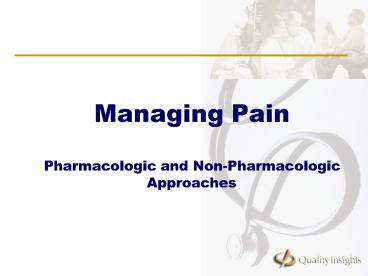Managing Pain Pharmacologic and NonPharmacologic Approaches PowerPoint PPT Presentation
1 / 34
Title: Managing Pain Pharmacologic and NonPharmacologic Approaches
1
Managing PainPharmacologic and
Non-Pharmacologic Approaches
2
Pain Definition
- Pain refers to any type of physical pain or
discomfort in any part of the body - Pain may be localized or more generalized
- Pain may be acute, chronic, continuous,
intermittent, occur at rest or with movement
3
Factors Associated With Chronic Pain In The
Elderly
- Oral or dental pathology
- Chronic leg cramps
- Peripheral vascular disease
- Post-stroke syndrome
- Immobility, contractures
- Amputations
- DJD
- Rheumatoid Arthritis
- Low back disorder
- Osteoporosis
- Neuropathic pain
- Headaches
- Pressure ulcers
4
Total Pain The Complex and Interrelated
Dimensions of Pain
5
The ABCs of Pain Management
- Always ask the patient
- Assess the pain and side effects systematically.
- Believe the patient and family
- Choose appropriate pain control
- Deliver medication in timely manor
- Empower and Educate patients and their families
- Enable patients to help control their treatment
6
Pharmacologic Approach to Pain Management
7
Pharmacologic TreatmentWorld Health
Organization (WHO)
8
WHO Approach
- Five Concepts
- By mouth
- By the clock
- By the ladder
- For the individual
- Pay attention to detail
9
STEP 1Mild to Moderate Pain
- Acetaminophen (2.5-3.5 grams)
- NSAIDS (no prolonged use)
- Motrin, Relafin, Trilisate
- Adjuvant medications
- Cox-2 Inhibitors
- Vioxx, Celebrex
10
COX-2 Inhibitors
- Advantages
- Better safety profile
- Selective inhibitor
- Fewer side effects
- Fewer drug interactions
- Disadvantages
- Allergies
- GI disturbances
- Asthma
- Elevated LFT
- Renal function
- Heart failure/fluid retention
- Requires monitoring of Renal Liver functions
and CBC
11
STEP 2Moderate to Severe Pain
- Addition of combination opiate to Step 1 drug
- Vicodin or Lortab, Vicoprofen
- Percocet
- Tylox Tylenol 3
- Be aware of the total daily Tylenol dosage
- Tramadol (Ultram)
- Morphine, Oxycodone
12
STEP 3Severe Pain
- Substitution of Step 2 agent
- Morphine or Oxycontin preparation
- Oxycodone, Dilaudid
- Fentanyl patch (2nd line)
- Use of short and long acting preparation
- Combine with adjuvant
13
Opioids
- Long acting opioids
- Methadone-Sustained release products
- Transdermal fentanyl
- Meperidine
- Metabolic accumulation
- Fentanyl patch
- Ease of administration
- Difficult to titrate- slow onset
- Absorption affected by muscle mass
14
Adjuvant Analgesic in Pain Management
- Achieves a more favorable balance between side
effects and pain relief of - Neuropathic pain
- Visceral pain
- Bone pain
15
Adjuvant Analgesics
- Steroids
- Antidepressants
- Anticonvulsants
- Antispasmodics
16
Proactive Pain Management
- Anticipate painful events
- Avoid PRN dosing (
- Use long/short acting combination
- Timing of administration of one has no relation
to timing of administration of the other - Treat pain early and aggressively
- Anticipate swallowing problems
17
Recognition and Prevention of Side Effects
- Constipation
- Nausea/vomiting
- Sedation/confusion
- Respiratory depression
- Drug accumulation
- Myoclonus
18
General Recommendations
- Initiate pain management with immediate release
form- adjust as needed - Once at optimal dose - switch to extended release
preparations - Breakthrough medication on board
- 2-4 days for dose titration (long-half life)
- Chronic pain Around the Clock
- Acute pain -PRN
19
General Recommendations
- Reassess pain if opioid needs are changed
- Determine need for adjuvant therapy
- Employ oral route of administration
- Avoid IM route of administration
- Avoid Meperidine and Propoxyphene
- Use preventive bowel regimen
20
Case Study
- Customer is 82 years old with prostate cancer,
dementia, incontinence, and admitted after
pneumonia. He is complaining of severe pain,
mostly in legs and back. Demerol/Vistaril
ordered in hospital. - What type of pain syndrome is likely?
- What would be your approach?
21
Non-Pharmacologic Approach To Pain Management
22
The Pain Cycle
PAIN
DEPRESSION
LIMITED/LOST ABILITIES
STRESS
23
ACTIVITY ACTIVITY
24
Non-Pharmacologic Approaches
- Exercise and mobility training
- Heat, cold, massage, ultrasound, paraffin, and/or
TENS - Positioning and/or splinting
- Education
- Stress management techniques Biofeedback,
relaxation, stress reduction - Other techniques
25
Who can provide these techniques?
- Rehabilitation department (Skilled facility)
- Activities department/Recreation Therapy
- (Skilled facility)
- Nursing
- Physicians
- Therapists
26
Therapeutic Exercise
- Range of motion
- Strengthening
- Endurance training
- Aquatic therapy
- Functional mobility training
27
Modalities
- Heat warm compress, hot packs and/or K-pads
- Cold ice pack, cold pack or ice massage
- Massage
- Ultrasound
- Paraffin
- TENS
28
Positioning and/or Splints
- Bed positioning
- Wheelchair positioning
- Splinting
- Upper extremity
- Lower extremity
- Spinal
- EDUCATION
29
Patient/Caregiver Education
- Posture
- Body mechanics
- Benefits of rest
- Joint protection
- Energy conservation
30
Other Techniques
- Biofeedback
- Relaxation techniques
- Stress reduction
- Aromatherapy
- Pet Therapy
31
Other Techniques
- Hypnosis
- Acupuncture
- Meditation
- Yoga
32
Team Approach
- Communication
- Coordinate pain management with functional
activities
33
Questions?
34
This material was prepared by Quality Insights of
Pennsylvania, the Medicare Quality Improvement
Organization for Pennsylvania, under contract
with the Centers for Medicare Medicaid Services
(CMS). The views presented do not necessarily
reflect those of CMS. Publication number
7SOW-PA-NH05.309.

